Tomsk: what to see in the city
Tomsk is one of the most friendly and hospitable cities in Russia. People here are proud of beeing its citizens. They are never in hurry to earn all the money on Earth. They have esteem for themselves and others. If you come across, they will greet you; if you need any assistance, they will help you. And the city itself is alike – with lots of walking malls and quiet street, parks, cafes and food stalls. Walking around here is recommended.
Tomsk has a status of “historical city”. Its layout started forming in 17th century, and historical districts date back to that time. It owes its architectural uniqueness to the wooden architecture, of which it has many masterpieces, built on the border of 19th and 20th centuries. Also it has numerous buildings in modernist style of the same epoch, and many churches, which are interesting in themselves and keep memories of historical events and personalities.
The historical part of the city stretches from north to south along the eastern shore of Tom’ river. Its southern end is Lagerny Sad (Camp Garden), called so because in 19th centure there stood a camp of Tomsk garrison. Now it’s a park of birch and fir trees, with straight lanes and Tom’ quay. The river makes almost 90 degree turn here, and there is a majestic view over the powerful river and the opposite bank. In the center of the park stands volumnious monument to the soldiers of World War II, where are listed all the Tomsk citizens who died in the fields of combats. From Camp Garden starts the main street of the city, now bearing the name of Lenin. It goes through all the city to the north, imitating the direction of Tom’ river.
The district from Camp Garden to the intersection of Lenina and Kirova streets has an historical name of Verhnaya Elan’ (upper meadow). Till the beginning of 20th century there was a forest sheltering a convent and cemetery. At the intersection of Lenina and Kirova streets stand the buildings of Tomsk Polytechnical University (formerly Tomsk Technical institute), built in the beginning of 20th century. Here begins the historical district of Nizhnaya Elan’ (lower meadow), which in the middle of 19th century became the new city center, with all the government and official buildings. After we pass the Polytechnical University, on the left-hand side  of the street starts the area of green with white building in classical style in the middle. This is Botanical Garden and Tomsk State University, the oldest in Siberia, built in 1888. As we pass the garden and buildings of some other educational institutes, we arrive to Novosobornaya (new cathedral) Square, designed as a siege for regional authorities when Tomsk was appointed an administrative center in 1804. The square owes its name to St.Trinity
of the street starts the area of green with white building in classical style in the middle. This is Botanical Garden and Tomsk State University, the oldest in Siberia, built in 1888. As we pass the garden and buildings of some other educational institutes, we arrive to Novosobornaya (new cathedral) Square, designed as a siege for regional authorities when Tomsk was appointed an administrative center in 1804. The square owes its name to St.Trinity  Cathedral, built in 1845 and destroyed in 1934. Now this square is a pleasant garden with monument to students in its center. To the east of this square (on the right-hand side of our motion) lies the body of Nizhnaya Elan’, dense with fancy houses of tradesmen and social persons of the beginning of 20th century. Here are some addresses: Krasnoarmeyskaya street 68, 67, 67a, 71, Tverskaya str. 66, Vershinina str. 12, Belinskogo str. 19, Gagarina str. 42. Few steps to the south of the square, in Herzena street, stands Alexander Nevsky church, built in 1877.
Cathedral, built in 1845 and destroyed in 1934. Now this square is a pleasant garden with monument to students in its center. To the east of this square (on the right-hand side of our motion) lies the body of Nizhnaya Elan’, dense with fancy houses of tradesmen and social persons of the beginning of 20th century. Here are some addresses: Krasnoarmeyskaya street 68, 67, 67a, 71, Tverskaya str. 66, Vershinina str. 12, Belinskogo str. 19, Gagarina str. 42. Few steps to the south of the square, in Herzena street, stands Alexander Nevsky church, built in 1877.
Let’s continue our walk along Lenina street. Its stretch between Novosobornaya square and Ushaika river keeps largely its aspect of the beginning of 20th century, with 3 or 4 storey buildings in neoclassical and 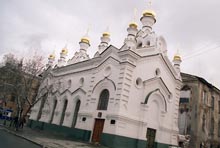 modernist style, with ground floors occupied with shops, boutiques, cafes etc. On the left-hand side, between Lenina street and Tom’ river, lies the historical district called Tatarskaya Sloboda (tatar settlement). Since 17th century, there lived muslim tatars, who always were a significant part in Tomsk population. They were the most proficient in horse trade – that’s why a horse in Tomsk arms; the main square of the district is called Konnaya (Horse) square. Among the historical monuments of this district – houses of rich horse-traders Moskov (Tatarskaya str.46) and Karim-bey (Gor’kogo str. 35), White Mosque (Moskovsky trakt, 43), and Red Mosque (Tatarskaya str.22), all built in the beginning of 20th century.
modernist style, with ground floors occupied with shops, boutiques, cafes etc. On the left-hand side, between Lenina street and Tom’ river, lies the historical district called Tatarskaya Sloboda (tatar settlement). Since 17th century, there lived muslim tatars, who always were a significant part in Tomsk population. They were the most proficient in horse trade – that’s why a horse in Tomsk arms; the main square of the district is called Konnaya (Horse) square. Among the historical monuments of this district – houses of rich horse-traders Moskov (Tatarskaya str.46) and Karim-bey (Gor’kogo str. 35), White Mosque (Moskovsky trakt, 43), and Red Mosque (Tatarskaya str.22), all built in the beginning of 20th century.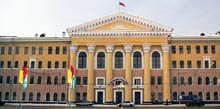 On the right-hand side of Lenina street on a small elevation lies a district called Yurtochnaya Gora (yurta hill; yurta is a kind of tent where siberian nomads lived), called so because Tatars lived here in 17th century before moving to Tatarskaya Sloboda. This district is untouched by glare of central streets and is made up presumably of half-ruined wooden houses of certain charm. The
On the right-hand side of Lenina street on a small elevation lies a district called Yurtochnaya Gora (yurta hill; yurta is a kind of tent where siberian nomads lived), called so because Tatars lived here in 17th century before moving to Tatarskaya Sloboda. This district is untouched by glare of central streets and is made up presumably of half-ruined wooden houses of certain charm. The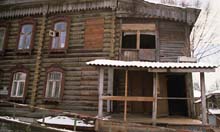 highlight and must-visit of the district is Holy Virgin Monastery of St Alexey (Bogoroditse-Alekseevskiy Monastyr’). It was founded in the year 1605 in some other place and brought here in 1663. The cathedral was erected in years 1776-1789, the belfry in 1860. This monastery is ranking high among the holy places in Siberia for its history and relics it has. The relics of St. Theodor of Tomsk, one of the most mysterious persons in the history of Siberia, are kept there.
highlight and must-visit of the district is Holy Virgin Monastery of St Alexey (Bogoroditse-Alekseevskiy Monastyr’). It was founded in the year 1605 in some other place and brought here in 1663. The cathedral was erected in years 1776-1789, the belfry in 1860. This monastery is ranking high among the holy places in Siberia for its history and relics it has. The relics of St. Theodor of Tomsk, one of the most mysterious persons in the history of Siberia, are kept there.
Going further along Lenina street, we arrive in district with ancient name Urzatka. This is the heart of the city, where buildings of the socialist 80s of 20th century stay side by side with those remaining from 18th century. Here in the stretch of eight hundred meters are located the majority of city’s attractions: boutiques, department stores, cinemas, Drama Theater, Philarmonic Society, State Art Gallery, administration and authorities of
Urzatka. This is the heart of the city, where buildings of the socialist 80s of 20th century stay side by side with those remaining from 18th century. Here in the stretch of eight hundred meters are located the majority of city’s attractions: boutiques, department stores, cinemas, Drama Theater, Philarmonic Society, State Art Gallery, administration and authorities of 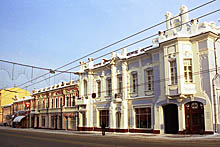 Tomsk region. The natural northern border of this district is Ushaika river, which, in addition to its wound course, now is hidden under the surface for several hunded meters. Where it appears, a peculiar bridge of year 1915 connects two shores. And here is the central square of the city, bearing name of Lenin. This square changed a lot of names during its history. Here, at the walls of fortified settlement, began the trade and craft city. On the square stands the first Tomsk cathedral – Epiphany (Bogoyavlensky) Cathedral. The first wooden building was constructed in 1630. The present building in baroque style had been built in 1777-1784. In this cathedral the formation of Tomsk province was proclaimed in 1804. Nearby also stands the former townhall, built in 1802-1812 (now it is hotel and restaurant).
Tomsk region. The natural northern border of this district is Ushaika river, which, in addition to its wound course, now is hidden under the surface for several hunded meters. Where it appears, a peculiar bridge of year 1915 connects two shores. And here is the central square of the city, bearing name of Lenin. This square changed a lot of names during its history. Here, at the walls of fortified settlement, began the trade and craft city. On the square stands the first Tomsk cathedral – Epiphany (Bogoyavlensky) Cathedral. The first wooden building was constructed in 1630. The present building in baroque style had been built in 1777-1784. In this cathedral the formation of Tomsk province was proclaimed in 1804. Nearby also stands the former townhall, built in 1802-1812 (now it is hotel and restaurant).
Lenina street goes further north from Lenina square. If we follow it further, we will get into historical Peski (Sands) district – space between Voskresenskaya hill and Tom’ river. It is an ancient trade area, that keeps this significance nowadays, with offices, shops, department stores, hotels. Architecturally it’s a mixture of impressive modernist buildings of the beginning of last century and modern constructions. On the quay of Tom’ river stands funny monument to writer Anton Tchekhov, who visited Tomsk more than hundred years ago making a journey through the entire Russian empire. Among other fancy buildings of the district is the former synagogue (Rosy Luxembourg str. 38), built in 1902.
But to the north-east from Lenina squre, that is to the right from the direction we move, starts the climb into the Voskresenskaya (Resurrection) hill – the cradle of the city. Passing by Roman-Catholic church, built in 1833 by exiled Poles, we make a sort of step 100 years back, arriving into area of wooden houses with immense gates and spacious yards, crooked paved 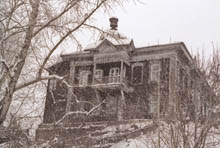 lanes, where float chimes and dog’s barking and people live in neighbourhood by generations knowing everything about each other. From certain places on the hill opens a view over the city. In Bakunina street, 26, stands one of the oldest dwelling houses of the city, build in the middle of 18th century for town major Frenchman Tomas Villeneuve. In this house, by invitation of Villeneuve, made a short stop on his way to exile in 1791 Alexander Radishchev, famous liberal writer. The hill is crowned by
lanes, where float chimes and dog’s barking and people live in neighbourhood by generations knowing everything about each other. From certain places on the hill opens a view over the city. In Bakunina street, 26, stands one of the oldest dwelling houses of the city, build in the middle of 18th century for town major Frenchman Tomas Villeneuve. In this house, by invitation of Villeneuve, made a short stop on his way to exile in 1791 Alexander Radishchev, famous liberal writer. The hill is crowned by 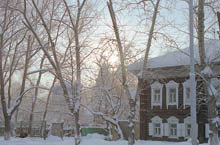 Resurrection Church – the jewel of baroque architecture, the construction of which began in 1789. Another impressive church in byzantine style – St.Trinity Church, built in 1836 - stands at the other end of the hill. At the eastern foot of the hill lies another wooden patriarchal district – Boloto (Swamp), where dilapidated houses alternate with officialy accepted and therefore preserved masterpieces of wooden architecture.
Resurrection Church – the jewel of baroque architecture, the construction of which began in 1789. Another impressive church in byzantine style – St.Trinity Church, built in 1836 - stands at the other end of the hill. At the eastern foot of the hill lies another wooden patriarchal district – Boloto (Swamp), where dilapidated houses alternate with officialy accepted and therefore preserved masterpieces of wooden architecture.
To the north-east of Voskresenskaya hill is located Solyanaya (Salt) square and Beloe Ozero (White Lake). In 17th century, here was the northern gate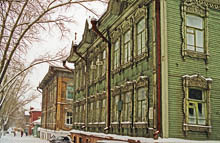 of the fortress, and at this gate stood salt storehouses and salt was released to people. The appearance of the square is formed by modernist buildings of the beginning of 20th century – Regional Court, House of Science, Architectural Institute. Beloe Ozero was always a center of outdoor fun and festivities, and now with a small park around it’s one of the favourite recreation points for Tomsk citizens.
of the fortress, and at this gate stood salt storehouses and salt was released to people. The appearance of the square is formed by modernist buildings of the beginning of 20th century – Regional Court, House of Science, Architectural Institute. Beloe Ozero was always a center of outdoor fun and festivities, and now with a small park around it’s one of the favourite recreation points for Tomsk citizens.


